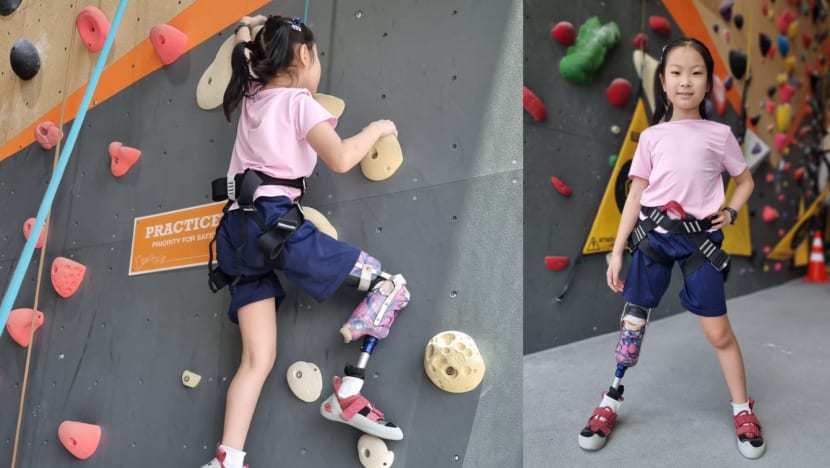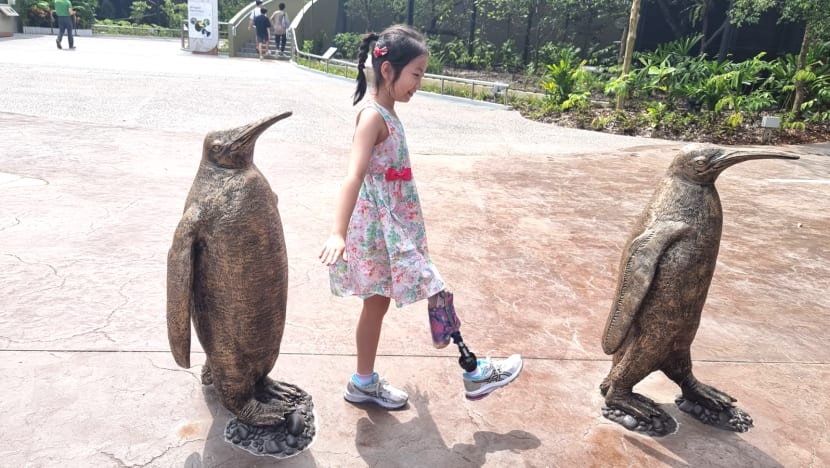Overcoming childhood cancer with courage, resilience and compassionate care
A paediatric haematologist-oncologist provides insights into osteosarcoma and its treatment in young patients.

Wearing a prosthetic limb, childhood osteosarcoma survivor Debbie Ong embraces adventures such as rock climbing. Photos: Icon Cancer Centre

This audio is generated by an AI tool.
Upon completing her final round of chemotherapy in February 2021, nine-year-old Debbie Ong enjoyed a heartfelt celebration organised by the medical team overseeing her care to honour her remarkable resilience.
For the young child, the celebration not only marked the conclusion of six intensive rounds of chemotherapy but it also symbolised a new chapter following a challenging battle with cancer.
At six, Debbie received a diagnosis of osteosarcoma, a form of cancer that originates in the bone-forming cells, typically affecting long bones in the arms and legs. In kindergarten at that time, she experienced pain below her knee and developed a noticeable limp when walking, her father Terence Ong, 49, recalled.
The cancer diagnosis came as a shock to the family. Adding to their distress, they were also informed that due to the tumour’s location, limb amputation would be required. “It was hard to believe that our child had cancer, but we had to quickly gather ourselves to prepare for the treatment ahead,” Mr Ong said.
Illustrating her diagnosis using age-appropriate terms such as “bad cells” and “very strong medicine” helped Debbie gain a better understanding her condition, he added.
WHAT IS OSTEOSARCOMA?
According to the Singapore Childhood Cancer Registry, there are more than 150 children and youths diagnosed with cancer each year in Singapore. Dr LeLe Aung, a senior consultant in paediatrics and paediatric haematology-oncology at Icon Cancer Centre (Mount Alvernia), shared that the most prevalent childhood cancer is acute leukaemia, while approximately 15 young patients are diagnosed with osteosarcoma yearly.
"Given its vague symptoms, early signs of osteosarcoma can be easily overlooked,” said Dr Aung, Debbie’s attending physician. She highlighted that children usually present with pain or swelling around the affected area.
“As children are extremely active, it is common to attribute the pain to excessive physical activity or a recent sports injury,” Dr Aung said. “Additional medical attention and imaging tests such as X-rays or MRIs are considered only when the pain persists and becomes unbearable.”
The exact cause of osteosarcoma in children remains unknown. However, certain factors are believed to heighten the risk. For instance, undergoing radiation therapy for a different form of cancer can increase the likelihood of an osteosarcoma diagnosis in the previously radiated bone, said Dr Aung. Additionally, children with retinoblastoma, a rare eye cancer, have an elevated risk of developing osteosarcoma later in life.
NAVIGATING TREATMENT

In the treatment of osteosarcoma, Dr Aung shared that a multidisciplinary treatment approach is key. The orthopaedic surgeon will perform a biopsy on the affected bone to verify the condition. Once a diagnosis of osteosarcoma has been confirmed, treatment proceeds in three phases. Pre-operative chemotherapy is first administered to shrink the tumour, eliminate small cancer cells in the blood stream and provide a window for the preparation of a prosthesis or the search for a suitable donor bone. Subsequently, the main surgery is performed to remove the cancer, followed by post-operative chemotherapy aimed at preventing cancer recurrence.
Dr Aung further explained that the type of surgery a child undergoes is thoughtfully determined through collaborative discussions involving the orthopedic surgeon, the treating team, the family and the child. “If the cancer has affected the growth plates, blood vessels or nerves, and performing a surgery to preserve the limb could affect the child’s life, amputation of the affected limb may be recommended,” she said.
For Debbie, the thought of losing the freedom to move around unhindered was a daunting prospect. After the treating team walked her and her parents through the various treatment options and how they could impact her range of motion, the family chose to proceed with rotationplasty. The surgical procedure involves the removal of a segment of a limb, while the remaining portion below the affected area is rotated and reattached to allow the patient better control, function and mobility. “We felt that it offered the best quality of life,” said Mr Ong.
Subsequently, Debbie’s rotationplasty surgery was scheduled after her first two rounds of chemotherapy.
Reflecting on the treatment process, Mr Ong shared that Debbie had to contend with the challenging side effects of chemotherapy, including weight loss. The post-surgery recovery journey was particularly arduous, he added. “The long days in the hospital and the multiple needles required for blood tests were the most difficult aspects of her experience,” he said.
Post-treatment, Debbie was prescribed supportive rehabilitation therapies to help her adapt to using a prosthetic limb.
Despite the hardships, Mr Ong revealed that the care, support and encouragement they received from people around them significantly influenced how the family coped with the treatment journey. “Many individuals gave up their seats on the MRT or bus and offered a smile or a word of encouragement,” he said, adding that his bosses and colleagues in the civil service sector provided steadfast support to him and his family during those trying times.
A NETWORK OF SUPPORT AND COMPASSIONATE CARE

Dr Aung believes that a multidisciplinary care approach is especially important when managing childhood cancers. “From the moment a diagnosis arises through treatment initiation and completion, a holistic team – including radiologists, pathologists, surgeons, nurses, counsellors and oncologists – works closely to maximise the child’s chances of successful treatment,” she elaborated.
Providing emotional support to the young patient is also a priority. Dr Aung noted that each child’s emotional and psychological response to diagnosis and treatment varies according to their developmental age. Gender matters, too. For instance, young girls may struggle with hair loss more than boys. “As such, the parents, nurses and I must be mindful of this and respond accordingly,” she shared.
For Dr Aung and her team, hosting a party for young patients on the final day of chemotherapy has become a tradition. She explained that it is an occasion to honour the child’s bravery, recognise the parents’ dedication and acknowledge the nurses’ compassion.
Today, Debbie’s long and painful days of being on a hospital bed are over. Now back in school, the cheerful and vivacious child is virtually unstoppable. Wearing a prosthetic limb, she enthusiastically participates in various activities, including playing table tennis, swimming, rock climbing and enjoying rides on her kick scooter.
For families navigating the childhood cancer journey, Mr Ong advises maintaining an optimistic outlook. “As parents, we have to first encourage ourselves and foster positivity, to ensure our child follows suit,” he said. “It’s also crucial to engage in activities such as playing games, watching television and listening to music. Having fun together enables us not to fixate on the treatment, its side effects and health outcomes.”
Find out more about paediatric cancers.














